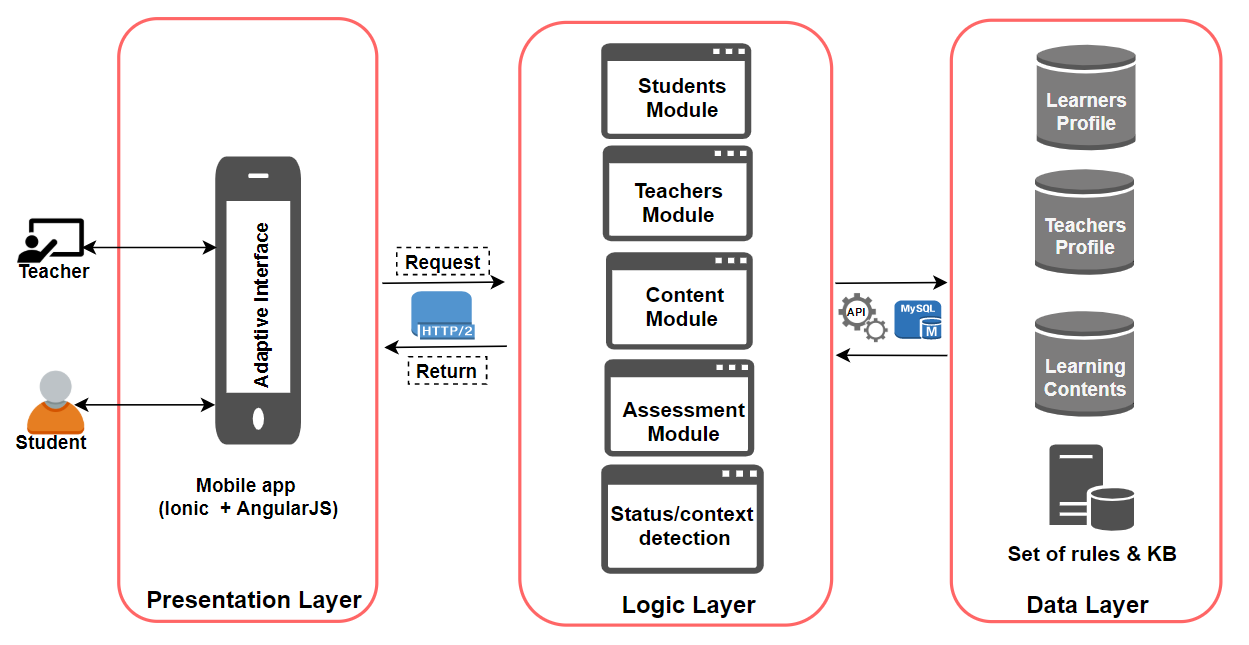Learning Activity 3: designing a SLE with a scenario
Learning Activity 3: designing a SLE with a scenario
Introduction
The first part of this page introduces a practical scenario of the design of a SLE and ask students to carry out two assignments. Task 1 is an individual work that requires each student to submit a file prepared according to the instructions provided in the task. Task 2 is group work and the task is based on the scenario presented (see the instructions below).
A practical SLE Design
Generally, Hwang (2014) gave a blueprint on how to design a SLE by identifying seven modules / aspects that are necessary:
1. A learning status-detecting module . This module detects learners' real-world status (eg, locations and learning behaviors) and environmental contexts (eg, temperature and humidity) via connecting to some sensing devices.
2. A learning-performance evaluation module . This module evaluates and records learners' performance by conducting tests online or in the real world.
3. An adaptive learning task module . This module assigns learning tasks to learners based on their learning progress, learning performance, personal factors and their learning objectives in all disciplines.
4. An adaptive learning content module . This module provides learning materials to learners based on the learning progress, learning performance, personal factors and the real-world status of individual learners.
5. A personal learning support module . This module provides learning support to learners based on their learning needs.
6. A set of databases for keeping the learner profiles and portfolios . The data in those databases are very helpful to the learning system in terms of providing suitable support to the students in the right place and at the right time.
7. An inference engine and a knowledge base for further learning inferences and support . The knowledge base is a collection of teaching and learning experiences and might contain decision making rules. The inference engine is a decision-making computer program that analyzes the current case based on the rules in the knowledge base.
SLE Design Scenario
Following the guideline provided by Hwang (2014), a smart learning environment to teach programming basics and concepts is being designed. The components in this SLE are teachers, students, smartphone, mobile App containing the system logic, and cloud server for data storage (see the proposed architecture in Figure 1 ).
This particular SLE architecture is expected to teach a simple programming topics / concepts like variables, assignment statements, conditional statements, etc. learners are envisaged to have a varied background with different knowledge, cognitive ability, location and contextual environment, in isolation or in a group. Students are expected to learn these basics of programming through their smartphone.
Proposed Design Model and Explanation

Figure 1: Architecture of a Smart Learning Environment
The presentation layer is a mobile app with an interactive user interface. It is expected to be implemented to allow cross-platform (interoperability) using HTML5, Ionic framework and JavaScript libraries (AngularJS).
The logic layer contains the modules that collectively provide a smart learning environment. It specifically models learners, teachers, learning contents and provide learning assessment. Also, automatically detect learner's status to allow for personalized supports.
- The student's module processes all inputs from students, real-time location, logs and other activities around learners
- The teacher's module manages all information regarding the tutors and their tutorials, instructions and tasks, evaluation and remarks, etc.
- The content module presents the pages to design / manage instructions, allow uploading of learning materials in text, video, audio, infographics, and other allowable formats.
- Assessment module gives the learner and the teachers the opportunity to visualize the learning progression by presenting an overview of the learning achievement.
- Learners status and context detection is an automatic function performed by the system by keeping logs of the individual learner, detecting the contextual scenarios around the learner in real-time such as temperature, noise, humidity, etc. and use the acquired data to determine the type of support that the learner needed. This is based on certain rules defined in the system.
Data Layer warehouses all the data and allow for its manipulations by running database queries and deliver records to the Logic layer, which is mirrored in the cloud to allow for storage of contents, ease accessibility, reuse of learning resources in a distributed manner.
-------------------------------------------------- -------------------------------------------------- -------------------------------------------------- --------------
Task 1
NOTE : This activity is individual-based. Each student is expected to submit on the due date March 06, 2020.
Pick one aspect of SLE provided below, search for an article / research that presents an example of a system that is focused on that aspect and briefly write a short review on it using this template . In each of the aspects, use the material provided as a starting point for your search
Aspects of SLE
- Feedback automation: ( see material )
- Intelligent content recommendation: ( see material )
- Self-regulated learning
- Personalized learning progression
- Context-aware learning: ( see material )
- Adaptive location-aware learning
- Automatic learning assessment: ( see material )
- Content / social adaptation: ( see material )
- Course authoring
In the template , you are expected to give a brief description of the system, give the authors, mention all the smart characteristics / features of the system and state how the feature was realized / implemented. Also, you are to state the context of the system, for example, what subject is the system teaching, what group or level of students, and in what location. Students that are able to give clear information on how a feature of SLE within the system under review is realized (model, algorithm, or protocol) will attract more points.
Upload the short review in the learning activity 3 submission: task 1 (individual work) page
Further info:
- In the aspect that asked, “how this feature of SLE was realized”, students are expected to present, if it exists, the explanation of what method was used by the authors to achieve the feature. For example, did the author (s) adopted / developed any model, theory, standard, algorithm, mathematical approach, etc? This information is usually presented at the methodology section of the research paper.
- On “context of use”, students are to briefly highlight the information such as what was the SLE focused on? was it to teach any specific subject / topic? was it designed for a certain group of users? any specific region, country, or institution?
Max points: 6
Due Date: March 06, 2020
-------------------------------------------------- -------------------------------------------------- -----------------------------------
Task 2
NOTE : Complete this task in groups that was created in module 1.
Step 1. Each group must select one aspect of SLE.
- Feedback automation -
- Intelligent content recommendation - Team 2 ( María Viola | Jacqueline Guzman | Silvana Temesio | Alicia Diaz )
- Self-regulated learning - Team 3 ( Paula Echenique | Lucía Alonso | Sofía Rasnik )
- Personalized learning progression -
- Personalized learning support -
- Adaptive context-aware learning -
- Automatic learning assessment - Team 4 ( Reyna Der Boghosian | Manuel Larrosa | Sofía García )
- Content / social adaptation -
- Course authoring -
- Adaptive location-aware learning -
- Socially aware -
- Personalized feedback - Team 1 ( José Fager | Alen Perez | Mariana Porta | Gabriela Da Rosa )
- High engagement learning
- Self-directed learning
Step 2: Reserve a topic for the group work in the topic reservation forum. The deadline for topic reservation is 04.03.2020.
Step 3: From the knowledge that you have gained in module 1, create a design by using any wireframe platform of your choice (eg draw.io , wireframe.cc , https://www.flaticon.com , https://fontawesome.com/) to show how this aspect of SLE can be represented / achieved.
For example, you can choose a topic on programming basics (variables declaration) or any other convenient topic and creatively show how you want to teach the topic and how a learner interacts within the topic.
In other words, the group is to create a design showing pages on how one of these features of SLE can be achieved during teaching and learning.
Attention:
- Your design is only showing interfaces in the form of wireframe / mockup / prototype.
- The design can be presented in a native app or web app view / form.
- Think of how the features of SLE you are designing can be realized, for example, showing how sensors from devices can be integrated into your design to enhance learners experience.
- Show the teachers aspect and learners aspect of the design.
- Feel free to be creative because more points will be awarded to groups with innovative design.
Upload the design in the learning activity 3 submission: task 2 (group work) page
Max points: 14
Due Date: March 15, 2020
-------------------------------------------------- -------------------------------------------------- -----------------------------------
References
Hwang, G. Definition, framework and research issues of smart learning environments - a context-aware ubiquitous learning perspective. Smart Learn Environ. 1, 4 (2014).
